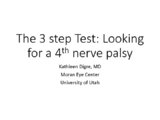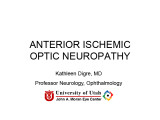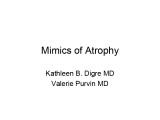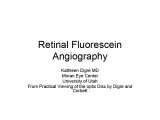John A. Moran Eye Center Neuro-Ophthalmology Collection: A variety of lectures, videos and images relating to topics in Neuro-Ophthalmology created by faculty at the Moran Eye Center, University of Utah, in Salt Lake City.
NOVEL: https://novel.utah.edu/
TO
| Identifier | Title | Description | Subject | ||
|---|---|---|---|---|---|
| 1 |
 |
The_3_Step_Test_Digre.pdf | The 3 Step Test: Looking for a 4th Nerve Palsy | Description of the three step test (3 step test) used when looking for a 4th nerve palsy. | 3 Step Test |
| 2 |
 |
Digre_AION | Anterior Ischemic Optic Neuropathy | PPT describing Anterior Ischemic Optic Neuropathy (AION). Covers clinical signs, such as monocular vision loss, swollen nerve, and visual field defects, as well as risk factors. | Anterior Ischemic Optic Neuropathy |
| 3 |
 |
Basal encephalocele | Basal Encephaloceles | Basal Encephaloceles | |
| 4 |
 |
Basic Headache.pdf | Basic Headache | Presentation covering an overview of headache and migraine. | Migraine, Headache |
| 5 |
 |
benign_episodic_unilateral_mydriasis | Benign Episodic Unilateral Mydriasis | Presentation covering benign episodic mydriasis. | Benign Episodic Mydriasis |
| 6 |
 |
Cone Dystrophy.pdf | Cone Dystrophy | PPT covering Cone Dystrophy - An inherited degeneration that presents between 10 - 30 years of age. Symptoms are decreased visual acuity, poor color vision, and sometimes light sensitivity. | Cone Dystrophy; Central Cone Dystrophy |
| 7 |
 |
Webvision-EOG-Creel | The Electro-oculogram: Clinical Applications | The electrooculogram measures the potential that exists between the cornea and Bruch's membrane at the back of the eye. The potential produces a dipole field with the cornea approximately 5 millivolts positive compared to the back of the eye, in a normally illuminated room. Although the origin of th... | Electro-oculogram |
| 8 |
 |
Webvision-ERG-Creel | The Electroretinogram and Electro-oculogram: Clinical Applications | The global or full-field electroretinogram (ERG) is a mass electrical response of the retina to photic stimulation. The ERG is a test used worldwide to assess the status of the retina in eye diseases in human patients and in laboratory animals used as models of retinal disease. | Electroretinogram; Electro-oculogram |
| 9 |
 |
Glaucoma the basics.pdf | Glaucoma: The Basics | Glaucoma is the most common optic neuropathy. Progressive cupping of the optic disc due to increased intraocular pressure together with visual field abnormalities and local disc susceptibility factors characterize this neuropathy. This PowerPoint lecture covers the basics of Glaucoma and includes ma... | Glaucoma; Optic Neuropathy |
| 10 |
 |
Herpes Zoster: Zoster Ophthalmicus with Third Nerve Palsy | Herpes Zoster Ophthalmicus with Third Nerve Palsy | Images showing presentation of Herpes Zoster (Zoster Ophthalmicus). | Herpes Zoster (Zoster Ophthalmicus) |
| 11 |
 |
Hydroxychloroquine Maculopathy (Plaquenil).pdf | Hydroxychloroquine Maculopathy (Plaquenil) | An overview of Chloroquine Maculopathy. | Maculopathy; Hydroxychloroquine; Plaquenil |
| 12 |
 |
Leber's Hereditary Optic Neuropathy | Leber's Hereditary Optic Neuropathy | Images and visual fields from a boy with acute visual loss. | Leber's Optic Neuropathy |
| 13 |
 |
Macula.pdf | Macula | Overview of the structure and viewing of the macula. | Macula; Retina |
| 14 |
 |
MELAS and RP.pdf | MELAS and RP | MELAS; Mitochondrial Encephalopathy with Lactic Acidosis, Stroke and Pigmentary Changes in retina-associated with a retinal dystrophy. This 53 year old man had seizures, encephalopathy and lactic acidosis typical of MELAS. His fundus examination showed granularity and some slight pigmentary changes ... | Mitochondrial Encephalopathy with Lactic Acidosis; MELAS Syndrome |
| 15 |
 |
Mimics of Atrophy | Mimics of Atrophy | Pseudo Atrophy | |
| 16 |
 |
Webvision-mfERG-Creel | The Multifocal Electroretinogram: Clinical Applications | The most important development in ERGs is the multifocal ERG (mfERG). Erich Sutter adapted the mathematical sequences called binary m-sequences creating a program that can extract hundreds of focal ERGs from a single electrical signal. This system allows assessment of ERG activity in small areas of ... | Multifocal Electroretinogram |
| 17 |
 |
Normal optic disc.pdf | Normal Optic Disc | Overview of the structure and function of the normal optic disc. | Normal Optic Disc Anatomy |
| 18 |
 |
Nutritional amblyopia.pdf | Nutritional Amblyopia | Example of patient with amblyopia with nutritional causes. | Nutritional Optic Atrophy; Wernicke's Encephalopathy |
| 19 |
 |
Optic Disc pallor pseudo and real.pdf | Optic Disc Pallor Pseudo and Real | Discussion of the causes of optic disc pallor. | Optic Disc; Optic Atrophy; Pallor |
| 20 |
 |
Optic disc anat variants ophthres 2012.pdf | Optic Disc: Anatomy, Variants, Unusual discs | Discussion of viewing the optic disc. Includes development of direct ophthalmoscope. Covers normal optic disc and nerve fiber; nerve fiber loss and defects; cilioretinal arteries; venous anomolies; papilledema; pseudopapilledema; myopic disc; hyperoptic disc; little red discs; megallopapilla; myelin... | Optic Disc; Anomolies; Anatomy |
| 21 |
 |
Optic nerve tumors benign and malignant.pdf | Optic Nerve Tumors Benign and Malignant | Discussion of optic nerve tumors including meningioma and glioma. | Optic Nerve Tumors |
| 22 |
 |
Papilledema 2013.pdf | Papilledema 2013 | Discussion of papilledema, the swelling due to increased pressure. | Papilledema |
| 23 |
 |
Retinal_Fluorescein_Angiography.ppt | Retinal Fluorescein Angiography | This slide set provides a brief description of Retinal Fluorescein Angiography. First introduced in 1960, sodium fluorescein, a dye, is administered through an angiocatheter (3-5cc) by a nurse or technician. The dye reaches the central retinal artery after passing through the heart and lungs. | Retinal Fluorescein Angiography |
| 24 |
 |
Retinitis pigmentosa disease of rods.pdf | Retinitis Pigmentosa Disease of Rods | Discussion of retinitis pigmentosa which is a retinal/choroidal degeneration caused by various genetic defects. | Retinitis Pigmentosa; Rods |
| 25 |
 |
Retino-choroidal Vessels or Optociliary veins or ciliary shunt.pdf | Retino-choroidal Vessels or Optociliary Veins or Ciliary Shunt | Overview of retino-choroidal collaterals, which are potential telangiectatic connections between the retina and choroidal circulation. Although sometimes called "shunts", these collaterals are between the retinal venous circulation and the choroidal venous circulation. | Retino-choroidal Vessels; Optociliary Veins ; Ciliary Shunt |
